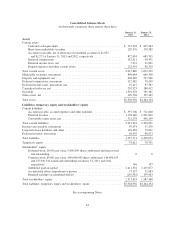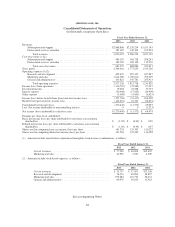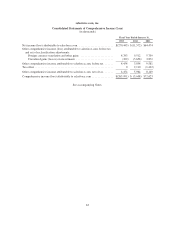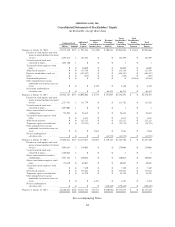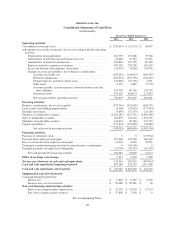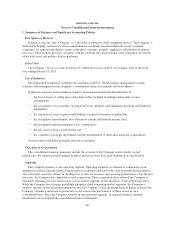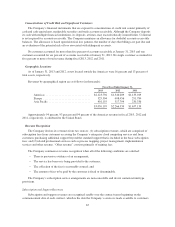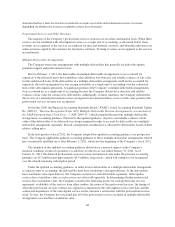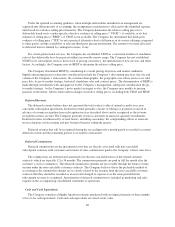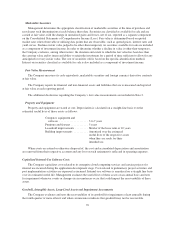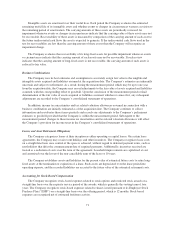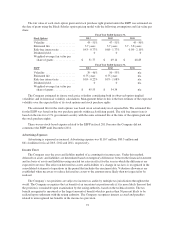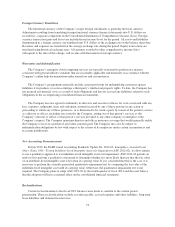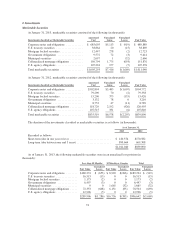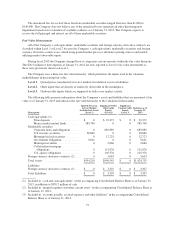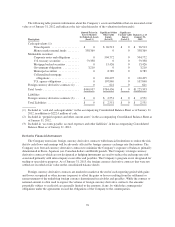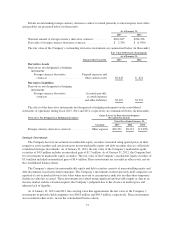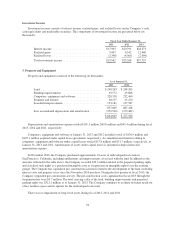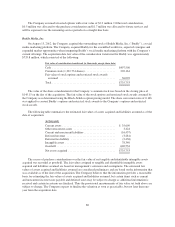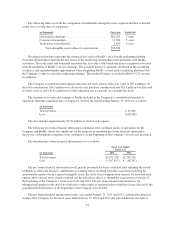Salesforce.com 2013 Annual Report Download - page 75
Download and view the complete annual report
Please find page 75 of the 2013 Salesforce.com annual report below. You can navigate through the pages in the report by either clicking on the pages listed below, or by using the keyword search tool below to find specific information within the annual report.Intangible assets are amortized over their useful lives. Each period the Company evaluates the estimated
remaining useful life of its intangible assets and whether events or changes in circumstances warrant a revision to
the remaining period of amortization. The carrying amounts of these assets are periodically reviewed for
impairment whenever events or changes in circumstances indicate that the carrying value of these assets may not
be recoverable. Recoverability of these assets is measured by comparison of the carrying amount of each asset to
the future undiscounted cash flows the asset is expected to generate. If the undiscounted cash flows used in the
test for recoverability are less than the carrying amount of these assets then the Company will recognize an
impairment charge.
The Company evaluates the recoverability of its long-lived assets for possible impairment whenever events
or circumstances indicate that the carrying amount of such assets may not be recoverable. If such review
indicates that the carrying amount of long-lived assets is not recoverable, the carrying amount of such assets is
reduced to fair value.
Business Combinations
The Company uses its best estimates and assumptions to accurately assign fair value to the tangible and
intangible assets acquired and liabilities assumed at the acquisition date. The Company’s estimates are inherently
uncertain and subject to refinement. As a result, during the measurement period, which may be up to one year
from the acquisition date, the Company may record adjustments to the fair value of assets acquired and liabilities
assumed, with the corresponding offset to goodwill. Upon the conclusion of the measurement period or final
determination of the fair value of assets acquired or liabilities assumed, whichever comes first, any subsequent
adjustments are recorded to the Company’s consolidated statements of operations.
In addition, income tax uncertainties and tax related valuation allowances assumed in connection with a
business combination are initially estimated as of the acquisition date. The Company continues to collect
information and reevaluates these items quarterly and records any adjustments to the Company’s preliminary
estimates to goodwill provided that the Company is within the measurement period. Subsequent to the
measurement period, changes to these income tax uncertainties and tax related valuation allowances will affect
the Company’s provision for income taxes in the Company’s consolidated statements of operations.
Leases and Asset Retirement Obligations
The Company categorizes leases at their inception as either operating or capital leases. On certain lease
agreements, the Company may receive rent holidays and other incentives. The Company recognizes lease costs
on a straight-line basis once control of the space is achieved, without regard to deferred payment terms, such as
rent holidays that defer the commencement date of required payments. Additionally, incentives received are
treated as a reduction of costs over the term of the agreement. Leasehold improvements are capitalized at cost
and amortized over the lesser of the non-cancellable term of the lease or 10 years.
The Company establishes assets and liabilities for the present value of estimated future costs to retire long-
lived assets at the termination or expiration of a lease. Such assets are depreciated over the lease period into
operating expense, and the recorded liabilities are accreted to the future value of the estimated retirement costs.
Accounting for Stock-Based Compensation
The Company recognizes stock-based expenses related to stock options and restricted stock awards on a
straight-line basis over the requisite service period of the awards, which is generally the vesting term of four
years. The Company recognizes stock-based expenses related to shares issued pursuant to its Employee Stock
Purchase Plan (“ESPP”) on a straight-line basis over the offering period, which is 12 months. Stock-based
expenses are recognized net of estimated forfeiture activity.
71


